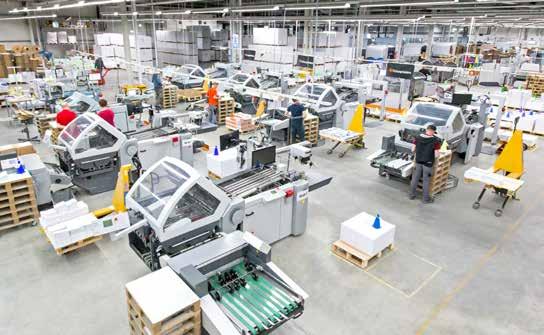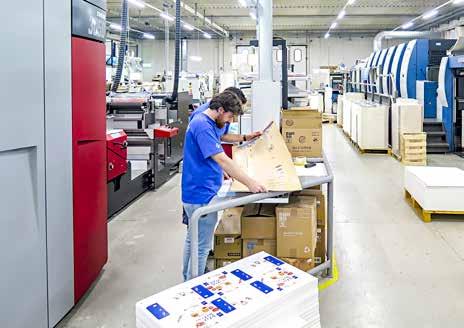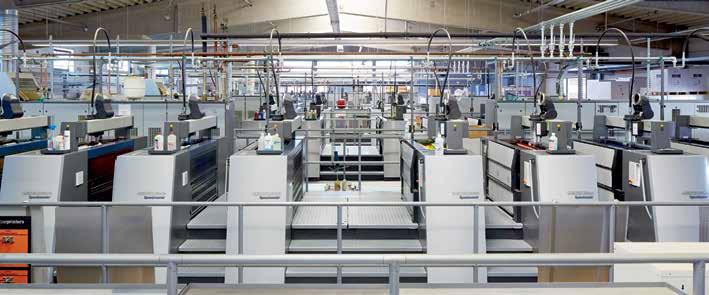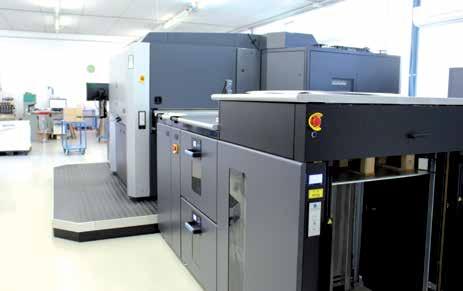
11 minute read
Online Printing grows
Between global trends and local patterns, online printing continues to grow
Mainstream operators, innovators, artisans and packaging professionals light up the web-to-print landscape – Lorenzo Villa
Advertisement
If the Internet has democratised access to information and social media have stimulated interaction between brands, retailers and consumers, Amazon has convinced buyers of all kinds and all ages that buying online is safe, comfortable and even rewarding. And printed products, although more complex and full of customisation and creativity, do not seem to be an exception. The first fledgling phenomena of online print sales go back to the 1990s, but it is only in the last decade that such sales have really taken on significant size, as large players progressively raise the bar in their services and investments and disproportionately broaden their product portfolio, their range of ancillary services, also the geographical reach. All this to the point whereby both the large national operators – those still without an online store, of course – and the thousands of small local print-service providers are all wondering how appropriate it is to enter an already crowded, mature arena. Above all they are asking themselves what the real prospects for growth and development are, and which investments have to be made. Although almost all online businesses have some elements in common – strong automation, effective quality management, impeccable customer care – online printing is not an exact science, nor does it provide for a common or standard organisational model that can be just adopted and copied indefinitely. The internet is instead a powerful interactive channel
Lorenzo Villa.
and as such it must be understood, exploited and supported. To find your own success-recipe and to ensure space for growth in the medium to long term, it’s first of all appropriate to analyse the market, the best practices and the moves of the most relevant operators.
1) Established companies set the example Favoured over other global economies because of the larger average size of their companies, the
Key Notes :
> Online Printing is not an exact science, nor does it provide for a common or standard organisational model. > German printers
have created stateof-the art online sales models with optimised workflows. > Today, packaging is the market that expresses the highest volumes, growth rates and margins & the most challenging segment to deal with.

United States and Germany are undoubtedly the Western countries that have best interpreted the concept of consolidation and concentration of business. In the case of the USA, the result is a vast market flying a single flag and speaking the same language, where giants such as vistaprint.com, controlled by Cimpress, are thriving. In Germany, success factors include the presence of significant technology manufacturers, trade shows, logistics infrastructure, skilled labour and an automation culture. Advantages that German printers have been able to exploit masterfully, optimising their workflows and creating stateof-the art online sales models which go way beyond clumsy ‘multilingual websites’ used to place orders here and there. The most successful online printers have made cultural and linguistic diversity their flag, hiring local staff across Europe, creating mother-tongue customer care infrastructure, sometimes opening national subsidiaries. The names are the emblazoned ones of onlineprinters. com, flyeralarm.com, unitedprint.com and others. Companies that are large in size but remain largely independent or familyowned. “The online printing market, and our company, in particular, benefits from four main factors,” explains Michael Fries, CEO of Onlineprinters GmbH. “First of all, there are still a significant number of customers who move from slower and more expensive purchasing processes to faster online orders. Another success factor is the increasingly international scope of our activities. Also, we are constantly evolving our focus from printing to e-commerce, to create an excellent customer experience at low prices. Finally, through integrated processes and centralised purchasing, we share a mutual benefit with our subsidiaries.” The German company, founded as a printing house in 1984, now employs more than 1,400 people and is the symbol of how a favourable geographical location, combined with fierce competition between compatriots of long tradition, can advance the quality of service and product. “We continue to aim for doubledigit annual growth, and we believe that the conversion from small, decentralised printers to large industrial e-commerce models will continue for many years to come. In our case, we are also expanding our product range with gadgets, textile applications and products that help our customers achieve their marketing goals.”
Packly - Xeikon and Koenig & Bauer

2) When online printing is artisanal and design-driven If online selling is synonymous with democratisation, it is reasonable to think that every printing business can benefit from this opportunity; surprisingly, even those who don’t have real (actual) production capacity and sometimes not even machinery. The most far-sighted entrepreneurs have understood that to be successful, it is necessary to break away from a generalist offer and build an original and recognisable recipe of their own. The American platform mycreativeshop.com was born as a large container of creative solutions, in which printing is only one of the possible outputs. “Among the parameters of my business idea


I considered it essential that it had to be scalable, automated, with a small or almost non-existent physical warehouse. I didn’t know anything about the world of design or printing, but I felt that the idea could work,” says Jason Frueh, founder and CEO of MyCreativeShop. The platform allows users to create a graphic design based on a fully customizable online template, without the support of a designer. Once the operation is complete, you can download your project and buy printing from a trusted vendor, generating the potential for many other offline printers. Or order it on the platform in the desired quantity. “A very small percentage of users order printing through us, so much so that, the related turnover is below 25% of the total. It’s also our most expensive revenue stream, as there’s a tangible cost associated with printing.” MyCreativeShop, which leverages CHILI Publish’s powerful automated publishing infrastructure, is a lightweight, scalable model that enables the American company to serve customers worldwide while remaining incredibly small.
Among the thousands of local experiences, the Italian skillpress.it is an example of how it is possible to digitise and bring online the art of typography. The small company, born from the love for typography of Maurizio and Marco Battiston, has chosen to subvert the logic of standardisation that characterises almost all online suppliers. Skillpress, whose firepower is limited to an HP Indigo 12000HD and a modern finishing department, has turned total freedom of size, substrate, grammage, finish and quantity into its strengths. “We invest a lot in training and advice to our customers for the choice of papers, finishes and binding methods; we also produce the single copy for them, and we treat each project as if it were unique,” explains Battiston. “Although many find it senseless and uneconomic, for us it is a winning model, and our customers recognize us as true craftsmen of online digital printing.”
3) Between decoration and hyper-verticalization, make way for solution makers! If design plays a crucial role in the development of “conventional” printing projects, its importance increases if we enter the field of unusual applications, with substrates and surfaces that have little or nothing to do with commercial printing and display graphics. It’s new territory, made up of operators that we could define as solution makers, able to satisfy a new printing demand, often creating an offer completely separate from that of other PSPs. Most of them have gained specific experience outside the graphic arts, to the point that their portfolio ranges from fabrics

to wallpapers, from photographic paper to pictorial canvas, up to gift-wrapping paper. This is the case of the American spoonflower. com, the Dutch motiflow.com and the Italian thecolorsoup.com, three businesses with different histories and sizes, all sharing a strong orientation towards textile substrates. But above all the desire to combine simple print output with an unlimited range of designs and patterns, searchable by theme or colour, sometimes scalable in size, created by young international designers, who find visibility and business opportunities on the platform. An open and meritocratic attitude that involves new stakeholders, and generates a spontaneous network of promoters for printing infrastructures. Among the solution makers, there are also those who have focused on niche applications, such as the British moo.com. Founded in 2006 by Richard Moss, the company has always been inspired by the passion of its CEO for extreme design and quality, which MOO uses to transform the segment of business cards, considered by many others as just a commodity. “The exchange of a business card is often the first time a potential contact, customer or investor interacts with a company or brand. Having a carefully designed premium card helps you stand out in a crowded market,” says Amanda Champion, Marketing & Communications Manager at MOO. “MOO is just over 12 years old and had £100 million in revenue in 2018. The business card market is booming and, looking at only the 600,000 new companies that open their doors each year in the United States, the market opportunities are obvious.”
4) Profiting from new segments: Packaging as the next big thing Today, packaging is the market that expresses the highest volumes, growth rates and margins. At the same time, except for promotional containers and gadgets, it is the most challenging segment to deal with. Making packaging involves managing a multitude of variables, such as the design of effective templates and die-cutting patterns, adherence to strict quality and safety standards, impeccable reproduction of spot colours, the use of enhancement, the integration of packaging into industrial packaging processes, the durability needed for shipping and for display at the point of sale and effectiveness (impact) in its interaction with consumers. For this reason, there are still few online print operators
who have introduced it, perhaps limiting themselves to simple products that can be made with standard papers, weights and sizes. Among the pioneers of web-topack, there is the Italian pack.ly, a software company founded in 2014 to open the way for designers, agencies, small converters or simply newcomers to design, approve and purchase online professional packaging. “We have found that the packaging industry was still conditioned by complex and expensive production methods, inaccessible to a large part of the market. That’s why we designed software that would make digital die-cutting and 3D rendering accessible to everyone,” explains Giuseppe Prioriello, Founder and CEO of Packly. Entirely web-based, but also accessible via API, Packly gives access to a library of models, fully customizable in size and substrate, to apply your graphic layout. At the end of the process, in addition to the interactive 3D preview, you can download the generated die path file, or place the order. Packly can produce and ship in a few days micro-orders (starting from a single copy) of folding carton boxes, digitally printed and die-cut with Zünd technology. But also medium and large runs, printed with Koenig & Bauer sheetfed offset presses, finished with BOBST converting lines or with a Highcon digital die-cutter. Labels deserve a separate chapter. Another vast and hyper-technical market, which online printers mostly treated as an ancillary service, providing stickers and small reels, or a little more. Unexpectedly, the CCL Group, the global giant of labels, is presenting itself as a real game-changer. With its self-adhesive skills and converting capacity to satisfy the most demanding brand owners, in 2018 the Canadian group launched online portals such as etikett.de in Germany and etichetta. it in Italy, and acquired established operators such as easy2name.com in the UK. 2020 it will be considered as an indisputable fact. It is therefore to be expected that the discussion will shift to digital transformation and the hybridisation of print-production processes. And that the strategic messages of organisers and exhibitors will increasingly focus on interconnection, automation and digitisation of the design, procurement, preparation, finishing, converting, inventory and logistics stages. As chance would have it, it is precisely these ingredients that have already added flavour to the online printing production and sales models, with yet more destined to make a difference.
About the author: Lorenzo Villa is a Print Engineer and Publisher.
He holds a degree in Graphic Arts, as well as technical, strategic and commercial skills. From the late ‘90s Lorenzo has led print industry publications. He’s been cofounder and General Secretary of the EDP
Will technology be the trigger? Although the ongoing supremacy of any successful business depends on the strategic capabilities of its management/ leadership team and on the skills of its workforce, new or evolving technologies continue to be a driving force for our industry, as well as being a trigger for new businesses. Over time at drupa 2000, 2004, 2008, 2012 and 2016 digital printing (inkjet in particular) has taken on increasing importance, to the point where it has become the main protagonist at the show and where at drupa
MOO Cotton Business Cards


Association. From 2010 he started serving innovative manufacturers as management consultant, specializing in product & business development, being involved in a number of projects within graphics, textile and packaging. Together with his partner Gabriele Lo Surdo, in January 2015 he founded Density and acquired Italia Publishers, driving an ambitious revitalization plan based on a new generation of B2B media, delivering our industry higher levels of knowledge and inspiration.








